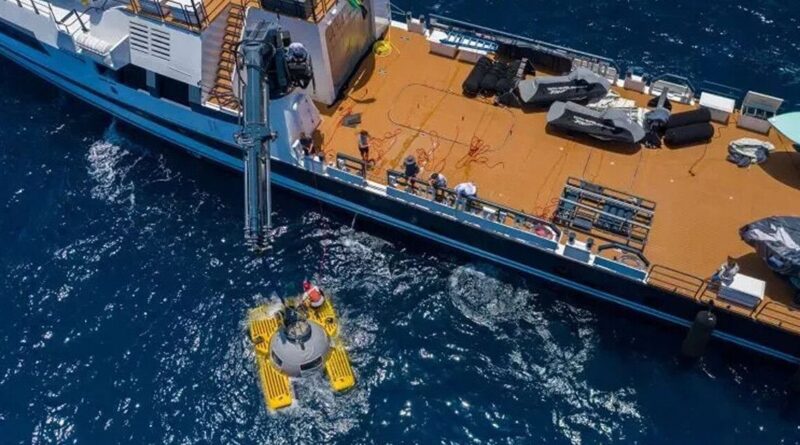Mysteries of pirate legends uncovered in new fascinating discovery | World | News
New investigations into a “legendary” shipwreck have revealed a connection to the infamous pirates of the Caribbean, who once operated out of Nassau in what is now the Bahamas.
This summer, Allen Exploration (AllenX) has been following a trail of wreckage leading south from where the 17th-century Spanish galleon, known as the Nuestra Senora de las Maravillas or “Our Lady of Wonders”, sank in what are now northern Bahamian waters.
The 891-ton, two-deck galleon, armed with 36 gleaming brass cannons, was constructed in northern Spain. However, the Maravillas met its end late at night on January 4, 1656, while en route to Cadiz, southwestern Spain, with approximately 650 people on board, most of whom died.
The galleon was struck by its flagship during a storm in the Florida Strait and collided with a reef, suffering significant damage.
At the time, it was laden with treasure, including a large amount of contraband and items salvaged from its supply ship, the Jesus Maria de la Limpia Concepcion, which had previously been lost off the coast of Ecuador. The Maravillas was one of the richest treasure ships ever lost at sea at the time.
James Sinclair, director of Archaeology for Allen Exploration, told Newsweek: “The Maravillas is famous because of the legendary riches it finally sailed with-at least five million pieces of eight and the same in contraband. The ill-fated galleon became the wreck of a wreck, losing both its treasure and the Concepcion’s.”
The Spanish salvors from Havana were the first to heavily salvage the wreck between 1656 and 1679, followed by English and colonial wreckers in the later 17th century.
Rediscovered by Bob Marx in 1972, the remains were once again subject to salvage operations by his team and subsequently by Marex, under the leadership of Herbert Humphries, until the early 1990s.
The Bahamian government, concerned about the unregulated nature of these treasure hunts, imposed a moratorium on wreck hunting in 1992.
During this summer’s explorations by AllenX, as detailed in an Ocean Dispatches report published by the Bahamas Maritime Museum, the team unearthed several new artefacts.
These treasures included grinding stones from the galleon’s kitchen, iron spikes that held the hull together, and a mix of Chinese and Spanish pottery, alongside silver coins from Mexico and silver bars.
While the AllenX team searched offshore using magnetometers and divers, its historians examined Spanish and English archives, researching how the wreck was “fished” for treasure in the second half of the 17th century.
The team was “surprised” to find that the first settlers in Nassau on the island of New Providence-now the most populous in the Bahamas-put down roots not to plant sugar and coffee but to salvage shipwrecks.
Carl Allen, director of AllenX, told the outlet: “Not only did the colonial authorities label the die-hards who dived the Maravillas ‘pirates’, real lawless pirates soon arrived in town too. They were attracted by loot, whether it was sunken or seized from ships sailing above water.
“We discovered a direct thread linking the loss of the Maravillas, its salvage, and the rise of Nassau as a wreckers’ supply base and pirates’ den.”
Historically, it was believed that the port town of Nassau, now the capital and largest city of the Bahamas, became a haven for pirates after a Spanish treasure fleet sank.
The fleet was one of the wealthiest in the world at the time and sank south of Cape Canaveral, Florida, in July 1715. The narrative suggests that pirates chose to settle there due to its strategic location for looting the wrecked fleet.
In the early 18th century, these infamous sea marauders, along with other notorious pirates like the Flying Gang, all made Nassau their base.
Sean Kingsley, editor-in-chief of Wreckwatch magazine, told the outlet: “AllenX’s new research pushes back the date when Nassau took off as a pirate port by over three decades and re-writes what sparked its birth. That trigger was sunken Spanish treasure-only loot lost in 1656 on the Maravillas in the Bahamas, not off Florida in 1715.”
Michael Pateman, director of The Bahamas Maritime Museum, provided insight into the scale of piracy during its golden age, noting that at their zenith, the pirates of the Caribbean numbered around 2,400 men.
He told the outlet: “The pirates who first settled in Nassau, though, by the early 1680s, were merchants turned pioneering chancers dreaming of finding freedom and great treasures on a few Spanish galleons sunk in the Bahamas. Top of their most-wanted hit list was the wreck of the Maravillas.”





